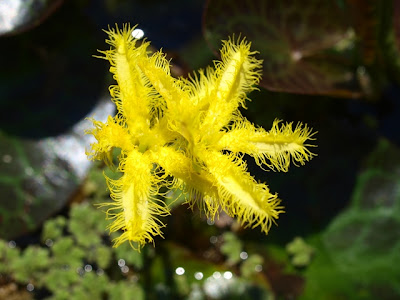Yellow snowflake melts in Melbourne's autumn sun
On the weekend I was walking through Melbourne's Royal Botanic Garden with Lynda, on the way to coffee and brunch (as one does in this fair city), and this yellow flowered water lily caught my attention. By the time I returned to photograph it the temperature had reached 35 degrees and the frilly flowers were clearly struggling, literally, to hold their (flower) head above water.
The water is in the Nymphaea Lily Pond and there are indeed nymphaeas growing in other parts. On the southern edge, near Birdwood Ave, however, you can see this little beauty.
It think* it's Nymphoides geminata, a local species (south-eastern mainland Australia and up the east coast further). The Flora of New South Wales calls it the Entire Marshwort which is rather prosaic. I suppose that's to do with the leaf and not the flower. Yellow Snowflake is a bit punchier, and seems more than usually appropriate to its response to today's heat.
I searched around for a few robust flowers to photograph and you see the daintiness of the flowers and their yellowness. The flowers of Nymphoides are borne above the water but today at least a few were struggling to break the surface. They are typically white, or like this one, yellow, and the petals often fringed with hairs or wings.
If I'd had my Flora of Victoria handy (it's on a ship somewhere between London and Melbourne) or it wasn't too hot to traipse across to the Royal Botanic Gardens' library, I'd have checked what we said about this lily back in 1999. A few days later I did this, and I'm still a little unsure.
I did discover that we (Helen Aston was the author, Neville Walsh and myself the editors) called Nymphoides geminata simply the Marshwort, applying the common name Entire Marshwort to Nymphoides montana (a species described by Helen that used to be buried, taxonomically, within Nymphoides geminata). Both species are described as having petals laciniate (i.e. cut deeply into narrow pointed lobes) rather than what profusely hairy as in the Nymphaea Lily Lake specimen.
Anyway, let's stick with Nymphoides geminata for now. Interesting, searching further in the internet I find Chocolate Waterfringe is another common name for this species.
Not bad. As you can see here, the leaves have a certain blotchy chocolateness to them and the flower, well it's fringed. But then I search further on the interweb and find other species of Nymphoides with this name, some with white flowers!
Maybe this is a species where aquatic plant enthusiasts have created a number of attractive cultivars. Or maybe I have misidentified the species in the first place - again, too hot to track down an expert... Better to take a step back and enjoy the spectacle of these yellow snowflakes melting into the Nymphaea Lily Pond on yet another gloriously summery autumn day in Melbourne.
*Postscript 5 January 2015: Well I may think that but others know... Colleague Neville Walsh collected a little from the lake today and identified the species (assuming it's the same) as Nymphoides crenata (Wavy Marshwort). This species has shallowly wavy leaf margins and petals with a fringed ridge along the middle on the upper surface (unlike all other Victorian species of this genus). In this case the leaves are variegated, but that's not typical of the species.




Comments
I think it is not the N. crenata. Please look at the image here to see the wavy leaf margins of the N. crenata:http://www.oregonaquatics.com/nymphoides-crenata-ruffled
Tim